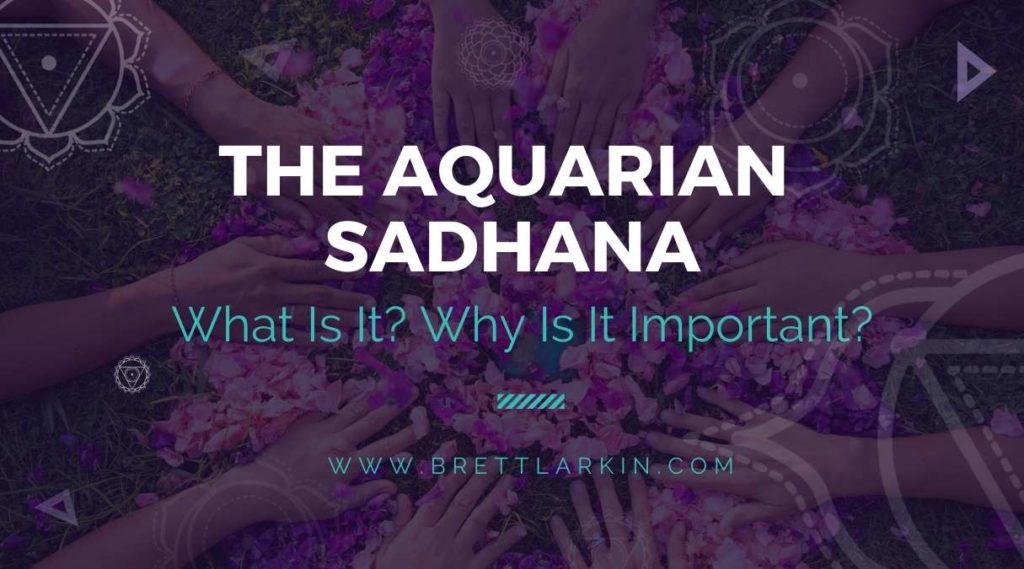
I like to say that the little things we do every day are more important than the “big” things we do every once in a while. If you’re a yogi, you know this is true! Just think about how it feels to get on your yoga mat after a couple of busy weeks where you just couldn’t find the time. It’s like – pretty hard, right? 😱 With the massive energetic shift we are currently experiencing in the Aquarian Age, our daily routine is the #1 most important thing to get right in the face of climate disaster, tech overwhelm, evolving gender roles, and like, the general chaos you see EVERYWHERE all the time.
The good news? 🤗 All of us have the opportunity in this transition to figure out what is and what isn’t working. You might remember that Yogi Bhajan gave us the 5 Sutras of the Aquarian Age to navigate this big shift. But do you know there’s a whole set of practices that are designed to help us deal with this exact moment? Yep! Enter: the Aquarian Sadhana.
The WHAT? Let’s break this down.
What Is Sadhana In Yoga?
Sadhana is a Sanskrit term that translates to “realization” or “to accomplish something”. In practice, it means a dedicated, daily spiritual practice. You could think of sadhana as a practice that requires your full awareness while having the intention of spiritual growth, since the overall goal of Sadhana is to achieve Samadhi (enlightenment).
Whether through asanas, meditation, chanting, or prayers, Sadhana encompasses any yogic ritual that encourages the practitioner to detach from the ego mind and establish a connection with divine consciousness or universal soul.
The Power of Ritual
Powerful rituals require dedication to connect our body, mind, and spirit. Brushing your teeth can be considered a morning ritual, but what makes a ritual powerful in the spiritual sense is the intention to integrate all parts of our being through the performance of a rite. You can brush your teeth without really thinking about anything at all, while still getting clean teeth. But to initiate spiritual growth, you need to be fully present throughout the practice.
In Sadhana, this means continuously showing up in order to turn down the mental chatter and expand our self- and other-awareness. In this process, we let go of anything that doesn’t serve us and focus on what’s important.
The amazing thing? This can look different to each of us – whether reciting mantras or prayers, or dedicating to a regular asana practice. You might even prefer to meditate, dive into self-study (svadhyaya), or focus on breathing exercises (pranayama).
The Aquarian Sadhana In Kundalini Yoga
In Kundalini Yoga, sadhana is the foundation of everything we do! It channels Kundalini energy upwards, awakening your inner vitality and potential. The most well known sadhana, which Kundalini Yogis from all over the world practice, is called the Aquarian Sadhana. Kundalini Master Yogi Bhajan offered this set of practices to his followers in the US, and variations of it are practiced widely today.
You Might Also Like: Kundalini Demystified
Traditionally, this sequence of spiritual practices is hosted during the amrit vela, the 2 1/2 hours before sunrise. It is called the “Aquarian” Sadhana because it has been specifically designed to support practitioners in the demands of the current astrological age – The Aquarian Age.
There are four parts to the Aquarian Sadhana:
- Preparation (i.e. taking a cold shower, dressing in white and putting on a turban)
- Reciting Japji (a Sikh prayer)
- Kundalini Yoga kriya
- The Aquarian mantras
Japji
What: Japji is a Sikh prayer written by Guru Nanak (the first Guru of the Sikh). A practitioner would usually begin this at 3.45am and it takes about 30 minutes to recite Japji.
Why: It’s a beautiful poem believed to carry the frequency of enlightenment.
The word Japji derives from Jap (to repeat) and Ji (soul). It is a crucial part of the Aquarian Sadhana due to the way it is structured and the power of its sounds. It is believed that through repetition of Japji one not moves energy through all of the chakras, but also awakens the soul to its true calling.
Kriya
What: Kriya is simply a set of yogic practices performed to achieve a specific outcome. In Kundalini yoga, kriyas include pranayama, mantras, mudras, and asana. The term kriya means “completed action” in Sanskrit.
Why: Kriyas help us to release tension and prepare body and mind for meditation practice.
The kriya part of the Aquarian Sadhana usually begins with chanting the Adi mantra “Ong Namo Guru Dev Namo” three times. The practitioner then chooses a Yoga practice that lasts for about 30 minutes and is concluded by Savasana. The kriyas prepare practitioners to receive the full benefits of chanting the Aquarian mantras. This is like the spring-cleaning part of the Aquarian Sadhana. It enables practitioners to sit back and enjoy the sunshine once finished!
The Aquarian Mantras
What: The Aquarian mantras, like any other mantras, are words/phrases that carry energetic charge. They are chanted to focus the mind.
Why: Each of the Aquarian Mantras is powerful on its own. They channel energy through the chakras and release blockages.
Mantras are a powerful tool to bring our mind into stillness by focusing on specific words. The Aquarian mantras are chanted for specific lengths of time. Each of them has a specific purpose, hence there is a particular order to them:
1. The Morning Call
“Ek ong kaar sat nam siri wahe guru”
Also known as the Adi Shakti Mantra or Long Ek Ong Kaar, this Aquarian mantra initiates Kundalini energy. Practitioners apply the neck lock for Kundalini to rise. It is chanted for 7 minutes and balances all of the chakras.
2. Wah Yantee
“Waah Yantee, Kar Yantee, Jag Doot Patee, Aadak It Waahaa,
Brahmaadeh Tresha Guru, It Wahe Guru”
This mantra brings stillness to the mind and unlocks our intuition. It is chanted for 7 minutes.
3. Mul Mantra
“Ek Ong Kar, Sat Naam, Kartaa Purkh, Nirbhao, Nirvair, Akaal Moorat, Ajoonee,
Saibung, Gur Prasad, Jap!
Aad Sach, Jugaad Sach, Hai bhee Sach, Nanak Hosee Bhee Sach”
Also chanted for 7 minutes, this mantra connects us to our inner Truth so that we can experience the consciousness of our soul.
4. Sat Siri Siri Akal
“Sat Siri, Siri Akaal
Siri Akaal, Mahaa Akaal
Mahaa Akaal, Sat Naam
Akaal Moorat, Wahe Guru”
This Aquarian mantra allows us to acknowledge that we are timeless, deathless beings so that we can move beyond the fear of endings. It is chanted for 7 minutes.
5. Rakhay Rakhanhaar
“Rakhay rakhanahaar aap ubaariaun,
Gur kee pairee paa-eh kaaj savaariun,
hoaa aap dayaal manaho na visaariun,
saadh janaa kai sung bhavajal taariun,
saakat nindak dusht khin maa-eh bidaariun,
tis saahib kee tyk Naanak manai maa-eh,
Jis simrat sukh ho-eh sagalay dookh jaa-eh”
According to Yogi Bhajan this mantra is “for protection against all negative forces, both inner and outer, which move against one’s walk on the path of destiny. It cuts like a sword through every opposing vibration, thought, word and action.”
6. Waheguru Wahejio
“Waheguru Waheguru Waheguru Wahejio”
For this mantra, sit in Virasana and then place your your right foot to the ground in front of your seat in a half-kneeling position. Place hands together in prayer pose. This mantra is chanted for 22 minutes moving you beyond your mind into bliss or the ecstasy of wisdom.
7. Guru Ram Das
“Guru Guru Wahe Guru, Guru Ram Das Guru”
The Guru Ram Das chant praises the Guru Ram Das filling us with humility and healing. It is chanted for 5 minutes.
8. Long Time Sun
The traditional end to the morning Sadhana is marked by singing this song.
A practitioner then might choose to bow their head to the Siri Guru Granth Sahib, the central holy scripture of Sikhism. Among Sikhs it is regarded as the eternal living Guru.
How To Practice the Aquarian Sadhana
If you’ve never been to an Aquarian Sadhana, I highly recommend this before setting up your own practice at home! It’s a super structured form of practice and it’s important to know how the mantras are sung to unleash their full potential. You might get lost in 2 1/2 hours of self-guided practice if you’re not sure how it should feel, sound and flow. If you’re brand new to Kundalini, try my 60 minute morning sadhana to get started:
- Snatam Kaur shares incredible tips and insights about the Aquarian Sadhana in her book “Original Light – the Morning Practice of Kundalini Yoga“
- If 2 1/2 hours right away sounds too overwhelming, start off with the beautiful Adi Mantra, which we chant at the beginning of every Kundalini Yoga class to tune into our higher consciousness and honor the lineage of teachers and students that have come before us. Or begin with the Morning Call and add on the other mantras one at a time.
- Be prepared. Pick out your clothes and set up your practice space so you can start your pre-dawn day smoothly and without interruptions.
- Set realistic goals. The Aquarian Sadhana is an incredible experience best practiced in community, but it’s more important to do a short sadhana every day than do the full Aquarian Sadhana every week. It is only through a dedicated daily sadhana that you will initiate noticeable change in your life.
Get 3 Free Training Vidoes from our Kundalini University Experience & Certification Program

YOU MIGHT ALSO LIKE
- Trauma-Informed Kundalini Yoga: A Heart-Centered Approach to Healing
- Harnessing the Power of Kundalini Divine Feminine for Transformation
- Kundalini for Feminine Energy: Ignite Your Creative Power and Passion
- Mastering the Sufi Grind: Benefits and Techniques for All Levels
- Kundalini Yoga for Chakras: An Uplifted Guide to Energy Balance
- Discover the Benefits of the Gobinday Mukunday Mantra for Well-Being
- Nabhi Kriya: Ignite Your Inner Fire and Personal Power
- Ek Ong Kar Sat Gur Prasad: Kundalini Mantra For Manifestation
- Tantric Har Chant: How It Fuels Prosperity and Inner Power
- Powerful Mantra for Protection Against Negative Energy and Harm
- The Power of Humee Hum Brahm Hum Mantra for Connection and Healing
- The Sa Re Sa Sa Mantra: Connecting Breath, Light, and Creativity
- What Is The Ajai Alai Mantra In Kundalini Yoga?
- What Is Sat Nam Rasayan? How And When To Practice
- The Meaning Of Ang Sang Wahe Guru Mantra in Kundalini Yoga
Get 3 Free Training Vidoes from our Kundalini University Experience & Certification Program












